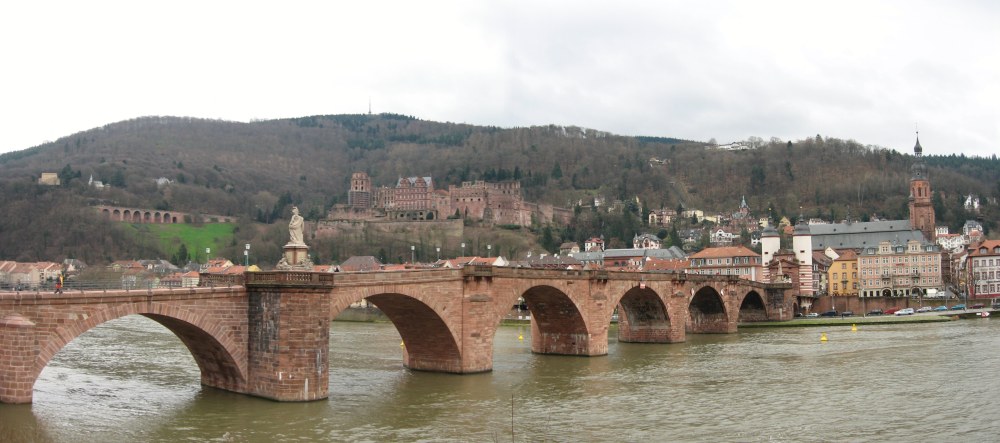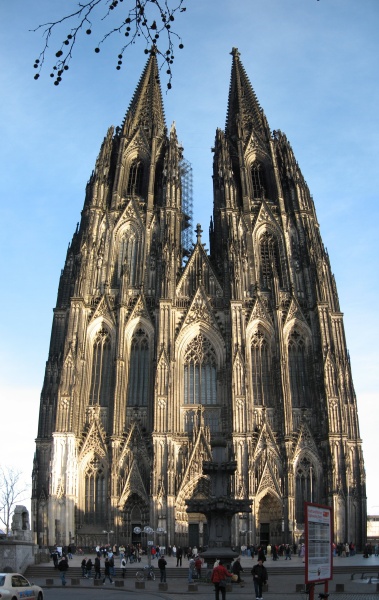I was fortunate enough to be selected for a project at work that will allow me to travel to Europe a few times. On this occasion, myself and few team members spent two weeks traveling to some of our factories in France, Germany, The Netherlands, and Spain. Traveling to Europe may sound cool and exotic, but it typically is not. One wakes up before dawn (this trip was in January so there was about 6 hours of daylight), goes to the office (inside), then when the workday is done (after dark) one usually crashes in the hotel or goes out to dinner with people from work. Not much excitement or sight seeing happening when you spend 10-12 hours with people from work and the only time you're outside is when it's dark. Europeans are generally on holiday when the sun is shining before 7am or after 6pm so not much work gets done.
However, on this particular trip, we got to spend the weekend in Mannheim, which is where Deere's European headquarters is located and very near the historic town of Heidelberg. Believe it or not, in all of my years of traveling for work this was the first-ever two-week trip I've taken. I've done over-weekend gigs for work before, but this was my longest duration trip. I was pretty tired when it was all done.
We arrived in Frankfurt at the start of the trip a few hours before one of our colleagues, so we decided to drive into the city centre and find out what we could see. We punched in the Frankfurt Dom into the GPS and started driving. We had landed a little after 6am and the sun didn't rise until about 8:30am (we had a Blackberry and looked it up!) so nice photos were going to be a challenge.
The left photo was taken in the Römer Square. In the photo you can see the steeple of the cathedral in the background, and some of the old buildings on the western façade. The right-hand photo shows the buildings of the east façade, which house the city's Rathaus (City Hall). It was only a couple weeks after Christmas so they still had the tree up.
To the north side of the square is the Alte Nikolai Kirche (Old Nicholas Church) shown in the left photo. Across the street from the square is the Paulskirche.
When you drive into the city centre from the A6 autobahn, one of the more striking things you see is the town's old water tower (Wasserturm). I believe it's over 100 years old, is just over 60 meters high and holds 2000m3. Today it's no longer operational, but rather, it is the centerpiece of a cool park (Friedrichsplatz) in the middle of town. Surrounding the park were a number of cool, old-looking buildings including this church dome (shown) and the Rosengarten Theater. Our hotel, the Dorint Sofitel Kongress Hotel, was about a block away from the park.
I give the mention of the Dorint because they give free passes to a great, American-style fitness center just a couple blocks away. The fitness center has good hours (open to 10pm in the evenings) and has three Concept 2 rowing machines. A huge plus! During our weekend, I went to use the rowing machines a few times and met Bernie, a 6 ft 5 in German financial planner, on the machine next to me. As soon as he found out I was American, he said that "he was a Trojan!" Apparently, he was the German junior champion in shot put and went to USC for a semester on scholarship. He had just picked up indoor rowing to get himself back in shape.
The very center of Mannheim is defined by a ring road and the city blocks within the ring are laid out grid style. Each grid has a number and letter associated with it. HERE is a good map of the city that shows the grid numbering. One morning, I walked around the city centre and snapped a few photos. Above (left) is a photo of the Paradeplatz, which is at the center of the grid system at grid location O1. Also above (right) is a bad photo of Schloss Mannheim (or Mannheim Palace). The building is huge and there are large buildings lining the other side of the street so one can't get a good enough angle on the building for a decent photo. I guess the building was mostly destroyed during World War II, but it was re-built and now houses portions of the University of Mannheim and other administrative offices.
William, one of the guys I work with, and I walked the few hundred steps from town to the Heidelberger Schloss (Heidelberg Castle). I had been to the castle briefly on a trip to Germany when I worked for Keithley, but this trip allowed us to explore the castle, it's gardens, and the old town a bit more.
The picture on the left was taken at the top of the path from top along the West Wall of the castle. The photo on the right shows the Exploded Tower in the foreground and the Gate Tower in the background. Most of the castle is in ruins, but not from World War II. As an example, The Exploded Tower was blown apart in 1693 during the War of Palatinate Succession. It apparently held the gun powder for the castle. The castle grounds and gardens were well into decline by the end of the 19th century, but now are one of Germany's most visited sites.
On the left is the Elizabeth Gate, which leads along the West Wall to the Thick Tower. On the right is the Gate Tower from inside the castle courtyard.
Here are a couple more photos from inside the castle courtyard: Ottheinrich Building (left) and the Friedrich Building (right).
The castle sits part way up a large hill. There is a cable car that takes visitors all the way to the top, but William & I climbed the couple hundred steps up to the castle from the car park. On the north side of the castle, facing the city, is the Great Terrace. The view is worth it! As you can tell, it was rather cloudy so my photos didn't come out very well. The photo on the left is facing west on the Great Terrace with one of the cupolas and the city in the background. The photo on the right shows the Bell Tower.
The photo on the left shows the Heiliggeistkirche from the Great Terrace. When we were walking around the town of Heidelberg I took the photo of the castle on the hill.

At the northeast edge of the gardens is the Scheffel Terrace, which as you can see affords a great view of the castle and city below.
One of the other cool features of the city is the Carl Theodor Bridge that crosses Neckar River. It's a pedestrian bridge so I took a ton of photos while strolling across. The left photo shows the Bridge Gate with it's distinctive twin towers and a statue of Carl Theodor in the foreground.
One of my favorite photos was of this barge. If you look closely, you'll see a car on the back of it with no obvious method to get it off. The barge itself has a small crane, but it didn't look to be sturdy enough or have enough reach. We figured that when the boat pulled into its destination one of the dock cranes were called into service. As we drove around more and more on the trip we noticed a large percentage of the river barges had cars on the back of them.

After crossing the bridge, I took this panorama photo of Heidelberg with the bridge in the foreground and the castle up on the hill behind it.
One of my little adventures on the trip was to drive to Eberbach, which is home to the largest (and arguably best) rowing shell maker in the world: Empacher. (N49 27.409 E8 59.276) Their distinctive yellow boats can be seen at every Olympics and World Championships. Eberbach is about a half hour upriver from Heidelberg, and the drive is gorgeous. I visited on a Saturday (my only day free) and they were closed, but I was able to take a photo of the "Empacher Pig" clad in the company's famous logos and yellow paint.
 |
|
|---|---|
On Sunday of our "free" weekend, we traveled to the north of Germany to overnight before meetings the next day. We left early so we could drive along the Rhein River (another beautiful drive) and have lunch in Köln. The dominate landmark of Köln is it's Dom, or cathedral. There are a number of buildings crowded around the cathedral itself so I had to take three photos and "stitch" them together to get the entire façade on the left. I couldn't get a decent panorama of the side of the building so I just included the one above. Apparently the best angle of the cathedral is from across the river, but we didn't have enough time to take the walk. Maybe next time... I took a number of photos inside the cathedral, but they are too dark to be interesting here. |
I say these are bonus photos because we weren't originally scheduled to visit Spain on this trip. After we landed in Germany, it was decided to extend the trip and spend two days in Madrid visiting another factory.
The one evening we were in town, I walked around with one of my colleagues, Rainer (with his buddy). He's based at our European HQ and has been to Madrid a number of times. We both enjoy the Spanish lifestyle and had a good time walking around. Later that night, we shared tapas and beer with a few more of co-workers. The photo on the right was from the first stop on our tour: the Plaza Mayor.
Continuing on our stroll we passed the Catedral de la Almundena (left photo) and the Palacio Real (Royal Palace) shown in the right photo.
A bit farther along the stroll (and past the homeless people smelling of urine) we came to one of Rainer's favorite parks: the Plaza de España. The centerpiece of the park is the Monument to Miguel de Cervantes who wrote Don Quixote. The left photo shows the entire statue with it's reflection in the pool. The right-hand photo is the bronze statue on the front of the monument of Don Quixote and his squire, Sancho Panza, on their horses.
At the entrance to the Plaza de España is the Gran Via (left photo), which is a bit like Times Square in New York City. There are tons of people, lights and shops all vying for one's attention. At this point, I left Rainer for a short bit so I could continue sight seeing. One neat building I saw was the Palacio Comunicaciones, which houses the post office headquarters.
© 2007 Doug Rathburn